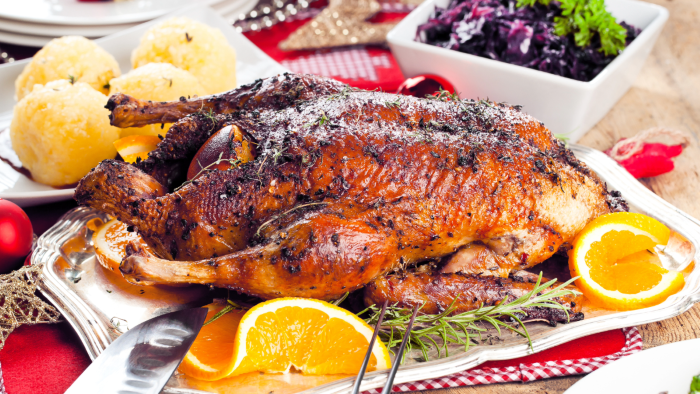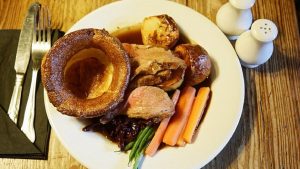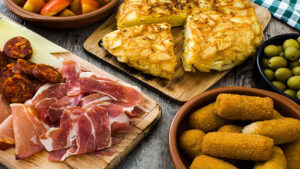
Goose is central to several dishes from around the world from the Martinsgans, Christmas Dinner, Teochew braised goose, to Hong Kong’s Cantonese goose leg rice. These dishes are bursting with many different flavours, requiring unique wine pairings, and we’ve been hard at work searching for the perfect match for your favourite goose dish. Let’s dig in!
Martinsgans
11 November marks Saint Matin’s Day which is celebrated in some areas in German-speaking countries with bonfires, lantern processions with traditional songs and roast goose. Called Martinsgans (literally Martin’s goose in English), it stems from the story of when Saint Martin, a former Roman soldier who entered the church, hid in a barn with a gaggle of geese to avoid being appointed a bishop and unfortunately for the humble saint, the geese gave away his position due to the noise they were making.
To commemorate Saint Martin, roast goose is traditionally enjoyed on 11 November served with red cabbage cooked in a vinegar, apple and red wine sauce, dumplings known as Klöße or Knödel, and a rich sauce. Doesn’t the idea of that just make your mouth water? Nowadays, you will find restaurants in Germany serving this goose dish throughout winter but especially between Martinstag and Christmas. When looking for a wine to marry with this dish, we don’t have to look no further than the wine produced in one of the countries that honours Saint Martin. So our first suggestion will be none other than a German Pinot Noir. The ripe, earthy wine will complement the goose wonderfully, bringing silky tannins, red berry flavours and gentle acidity. In this same breadth, a mature Riesling Kabinett with its honeyed notes and soft acidity would pair wonderfully, especially as the red cabbage tends to have a sweet edge.
We also have two other ideas for you. The first is a Burgundy Pinot Noir from the likes of Savigny-lès-Beaune, Givry or a generic Bourgogne Rouge. Their bright acidity will cleanse the palate after savouring the goose and their gentle tannins won’t clash with the sweetness of the red cabbage. Equally, their cherry, cranberry and red berry flavours will lift the game-y flavour of the meat. The second option is a Crozes-Hermitage or Saint-Joseph from the northern Rhône. These medium-bodied wines won’t overpower the meal and can standup to the richness of the sauce and the goose. Their plum, blackberry, and savoury herb flavours will also wonderfully contrast the sweet-sour flavours of the red cabbage, rounding off the meal exquisitely.
Cantonese goose leg rice
This Hong Kong comfort food invites a warming wine that can handle the goose’s fattiness and the flavours of its sauce. Roasted or slow-cooked, the goose leg is marinated for some time before cooking. The cooking juices are then used to make a sauce, and the leg is served with alongside rice and greens with the sauce poured over. This mouthwatering dish is the go-to for Hong Kong natives who want a hug in a bowl; it’s beloved for the caramelised skin and tender meat underneath.
When it comes to the wine to enjoy with this goose dish, we’re heading to France’s neighbour, Spain. Our first suggestion is a Priorat. The old Garnacha and Cariñena (or Carignan for those that are more familiar with the French name) vines growing on Catalonia’s hillsides dig their roots deep into the llicorella soil – formed of partially-decomposed slate and quartz. This nutrient-poor soil creates powerful, yet elegant red wines bursting with juicy cherry flavours and spice, which offsets the richness of the goose’s skin and the soy glaze.
The second option we have for you is a mature Rioja Reserva. From central Spain, these wines crafted from Tempranillo grapes spend at least 36 months ageing before being released onto the market and serving them alongside goose leg rice is a sure win. The soft tannins and acidity of aged Rioja help cut through the goose fat, while its earthy, leathery, and smoky notes echo the roast and caramelisation of the goose skin. The wine’s tertiary flavours of mushroom and leather will support the depth of flavours in the dish. Rioja’s tempranillo-based acidity and subtle oak spice will also cleanse the palate after each bite of delicious goose, preventing its greasiness from becoming overwhelming.
Teochew braised goose
To make this dish, goose is braised in a soy-based stock flavoured with cinnamon, star anise, cloves, and other spices. Adored in Singapore, the goose is sliced thinly and often served cold or at room temperature, with a dipping sauce. For those that have not yet experienced the joy of Teochew braised goose, it’s umami-rich, slightly sweet, and mildly spiced with tender meat and gelatinous skin.
For the wine to pair with this dish, we thought outside the box. Our first idea is a Chianti Classico from Italy’s beloved Tuscany region. The Sangiovese grape marries beautifully the soy, star anise, and spice profile of the braising sauce. What’s more, its high acidity will cut through the richness of the goose fat, and its medium tannins possess enough structure for the meat, without overwhelming the dish. The light, red cherry notes in the wine lifts the slightly sweet undertones of the dish and refreshes the palate, counterbalancing the salty-sweet glaze.
The second pairing idea is a mature Médoc from Bordeaux’s Left Bank. The Cabernet Sauvignon–led blends with their firm tannins and structure will work well with the fat and protein in the meat and skin. The wine’s blackcurrant, cedar, and tobacco notes will complement the soy and spices beautifully and as a mature wine will have developed leather and earthy notes, the pairing comes into its own because these notes mirror the savoury, umami flavours of the braised goose.
Christmas dinner
Now mainly overlooked for turkey, goose was, and sometimes still is, the meat of choice for Christmas Dinner in the UK. For those that love Charles Dinkins’ A Christmas Carol, it is said that Scrooge bought the Cratchits a goose – sorry we should say spoiler alert there for anyone looking forward to seeing it for the first time this Yuletide. Served alongside roast potatoes, parsnips, carrots, sprouts, stuffing and gravy, there are many flavours swirling around on the plate.
When searching for a wine, we needed to find something that can handle the rich, fatty goose meat and the sweetness and umami flavours from the side dishes. Not an easy task but we have a few ideas for you, the first being a Pinot Noir, especially those from Burgundy. Gevrey-Chambertin, Volnay and Beaune premier cru would make great options, as would a bottle from New Zealand’s Central Otago. Here, the wine’s acidity and red fruits are dazzling enough to cut through the goose fat, and its earthy notes harmonise with the vegetables and gravy. A Barolo and Barbaresco would also do the trick, containing aromas that complement the goose along with the right acidity to balance it out.
For white wine lovers, there are beautiful options for you too! An Alsace Pinot Gris has the right amount of acidity to handle the goose fat and its gentle sweetness pairs nicely with the vegetables on the plate. Another possibility would be a white wine from Meursault, Puligny-Montrachet, or Saint-Aubin. These rich and nutty wines with fine acidity would bring the dish together, almost as wonderfully as a Christmas present with a bow tied on top.
Bon appetit!



